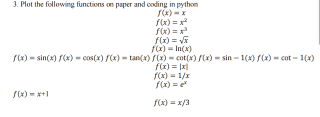您好,能用python 帮我解决这些问题吗

这是问题的列表,,能帮我解决吗?需要很快的时间,麻烦各位了!!
import numpy as np
from matplotlib import pyplot as plt
x = np.arange(-10, 10, 0.1)
y = x
plt.xlabel('x')
plt.ylabel('f(x)')
plt.title("f(x)=x")
plt.plot(x, y)
plt.show()
x = np.arange(-10, 10, 0.1)
y = x ** 2
plt.xlabel('x')
plt.ylabel('f(x)')
plt.title("f(x)=x^2")
plt.plot(x, y)
plt.show()
x = np.arange(-10, 10, 0.1)
y = x ** 3
plt.xlabel('x')
plt.ylabel('f(x)')
plt.title("f(x)=x^3")
plt.plot(x, y)
plt.show()
x = np.arange(-10, 10, 0.1)
y = x ** 0.5
plt.xlabel('x')
plt.ylabel('f(x)')
plt.title("f(x)=x^0.5")
plt.plot(x, y)
plt.show()
x = np.arange(-10, 10, 0.1)
y = np.log(1/x)
plt.xlabel('x')
plt.ylabel('f(x)')
plt.title("f(x)=ln(x)")
plt.plot(x, y)
plt.show()
import numpy as np
from matplotlib import pyplot as plt
data = {
'f(x)=x': lambda x: x,
'f(x) = x2': lambda x: pow(x, 2),
'f(x) = x3': lambda x: pow(x, 3),
'f(x) = Vx': lambda x: np.sqrt(x),
'f(x) = ln(x)': lambda x: np.log(x),
'f(x) = sin(x)': lambda x: np.sin(x),
'f(x) = cos(x)': lambda x: np.cos(x),
'f(x) = tan(x)': lambda x: np.tan(x),
'f(x) = cot(x)': lambda x: np.arctan(x),
'f(x) = | l': lambda x: abs(x),
'f(x) = 1 / x': lambda x: 1 / x,
'f(x) = é**x': lambda x: np.exp(x),
'f(x) = x + 1': lambda x: x + 1,
'f(x) = x/3': lambda x: x / 3,
}
for i in data:
x = np.arange(1, 20, 0.1)
y = data[i](x)
plt.xlabel('x')
plt.ylabel('y')
plt.title(i)
plt.plot(x, y)
plt.show()
import matplotlib.pyplot as plt
import numpy as np
x = np.linspace(-5,5,100)
y = x
plt.plot(x, y, '-r', label='y=x')
plt.title('Graph of y=x')
plt.xlabel('x', color='#1C2833')
plt.ylabel('y', color='#1C2833')
plt.legend(loc='upper left')
plt.grid()
plt.show()

- 你可以参考下这个问题的回答, 看看是否对你有帮助, 链接: https://ask.csdn.net/questions/7645226
https://blog.csdn.net/manchan4869/article/details/117295396
import math
# f(x) = x
def f(x):
return x
# f(x) = x2
def f(x):
return x**2
# f(x) = x3
def f(x):
return x**3
# f(x) = 根号x
def f(x):
return x ** 0.5
# f(x) = ln(x)
def f(x):
return math.log(x)
# f(x) = sin(x)
def f(x):
return math.sin(x)
# f(x) = cos(x)
def f(x):
return math.cos(x)
# f(x) = tan(x)
def f(x):
return math.tan(x)
# f(x) = cot(x)
def f(x):
return 1/(math.tan(x))
# f(x) = |x|
def f(x):
return abs(x)
# f(x) = 1/x
def f(x):
return 1/x
# f(x) = ex
def f(x):
return math.e ** x
# f(x) = x+1
def f(x):
return x+1
# f(x) = x/3
def f(x):
return x/3
import numpy as np
import math
f(x) = x
def fun_one():
try:
x = float(input("请输入x的值(必须是数值型):"))
print(x)
except Exception:
print("输入内容不符")
f(x) = x2
def fun_two():
try:
x = float(input("请输入x的值(必须是数值型):"))
print(x ** 2)
except Exception as e:
print("输入内容不符")
f(x) = x3
def fun_three():
try:
x = float(input("请输入x的值(必须是数值型):"))
print(x ** 3)
except Exception as e:
print("输入内容不符")
f(x) = Vx
def fun_four():
try:
x = float(input("请输入x的值(必须是数值型):"))
print(x ** 0.5)
except Exception as e:
print("输入内容不符")
f(x) = ln(x)
def fun_five():
try:
x = float(input("请输入x的值(必须是数值型):"))
print(np.log(x))
except Exception as e:
print("输入内容不符")
f(x) = sin(x)
def fun_six():
try:
x = float(input("请输入x的值(必须是数值型):"))
print(math.sin(x))
except Exception as e:
print("输入内容不符")
f(x) = COS(x)
def fun_seven():
try:
x = float(input("请输入x的值(必须是数值型):"))
print(math.cos(x))
except Exception as e:
print("输入内容不符")
f(x) = tan(x)
def fun_eight():
try:
x = float(input("请输入x的值(必须是数值型):"))
print(math.tan(x))
except Exception as e:
print("输入内容不符")
f(x) = cot(x)
def fun_nine():
try:
x = float(input("请输入x的值(必须是数值型):"))
print(np.arctan(x))
except Exception as e:
print("输入内容不符")
f(x) = | l
def fun_twelve():
try:
x = float(input("请输入x的值(必须是数值型):"))
print(abs(x))
except Exception as e:
print("输入内容不符")
f(x) = 1 / x
def fun_thirteen():
try:
x = float(input("请输入x的值(必须是数值型):"))
print(1/x)
except Exception as e:
print("输入内容不符")
f(x) = é**x
def fun_fourteen():
try:
x = float(input("请输入x的值(必须是数值型):"))
print(math.exp(x))
except Exception as e:
print("输入内容不符")
f(x) = x + 1
def fun_fifteen():
try:
x = float(input("请输入x的值(必须是数值型):"))
print(x+1)
except Exception as e:
print("输入内容不符")
f(x) = x/3
def fun_sixteen():
try:
x = float(input("请输入x的值(必须是数值型):"))
print(x/3)
except Exception as e:
print("输入内容不符")
PS:问答VIP年卡 【限时加赠:IT技术图书免费领】,了解详情>>> https://vip.csdn.net/askvip?utm_source=1146287632